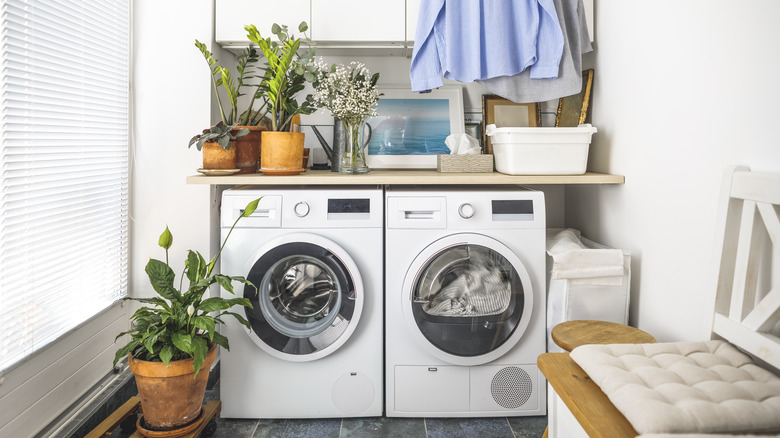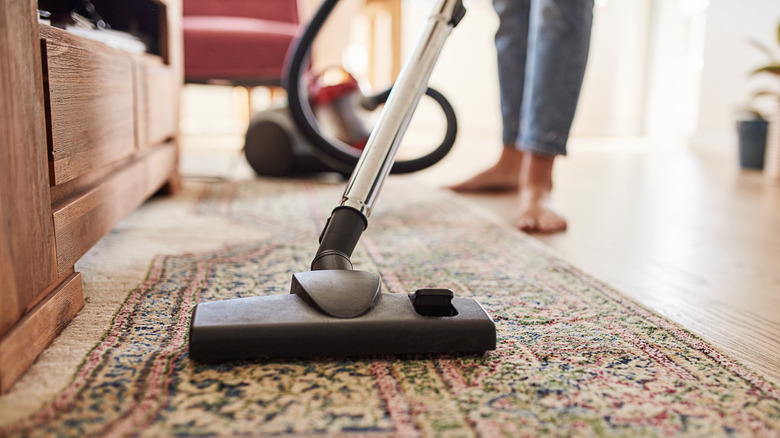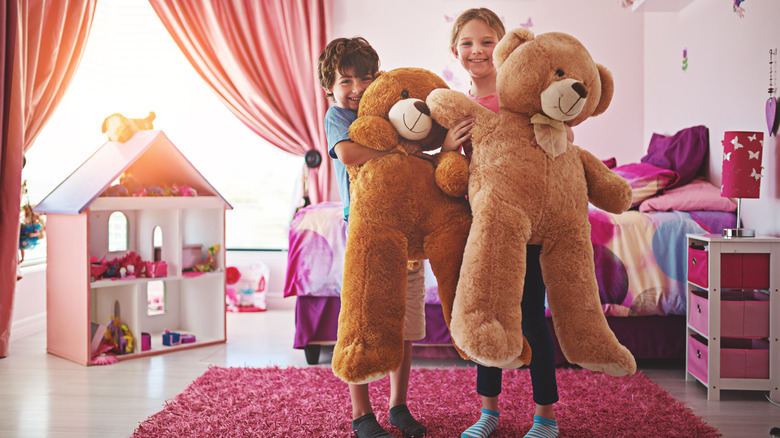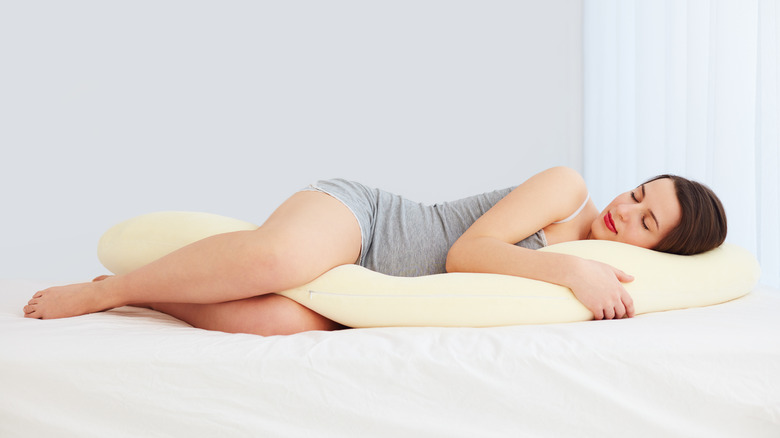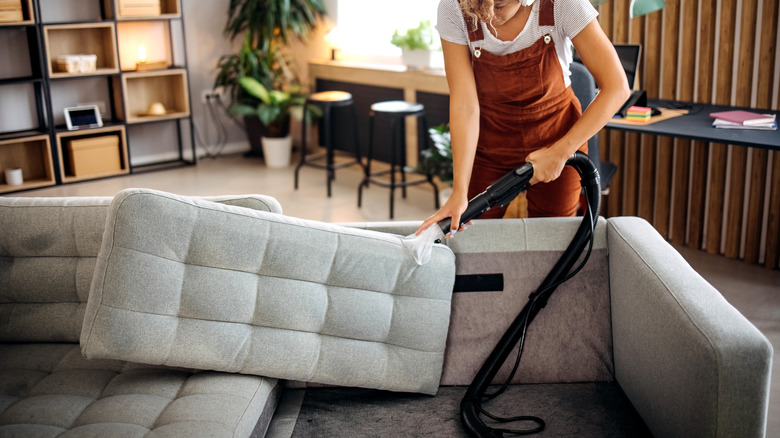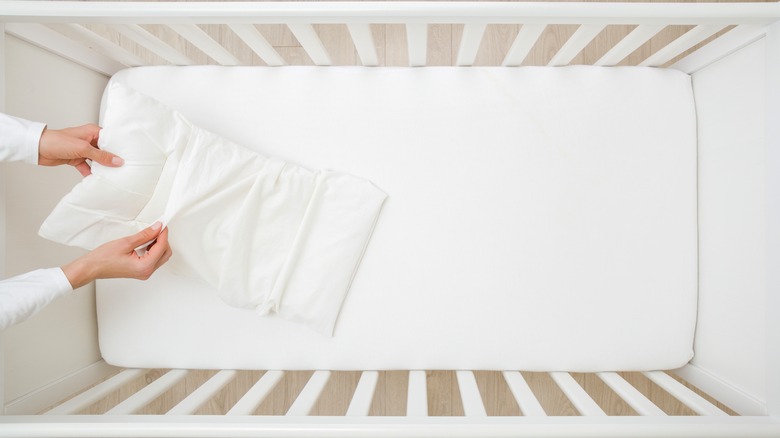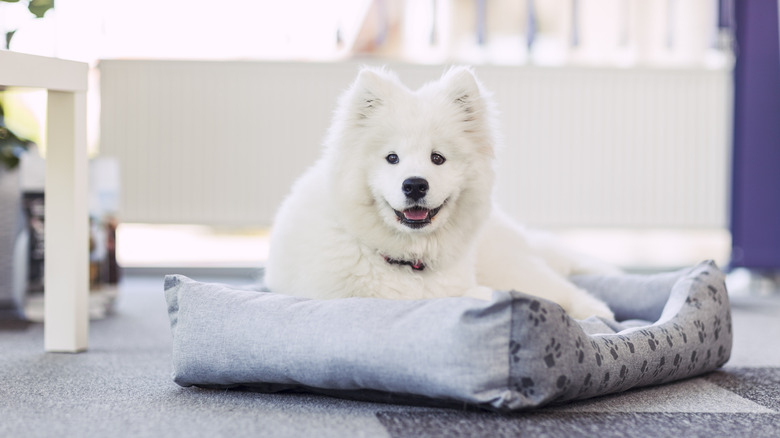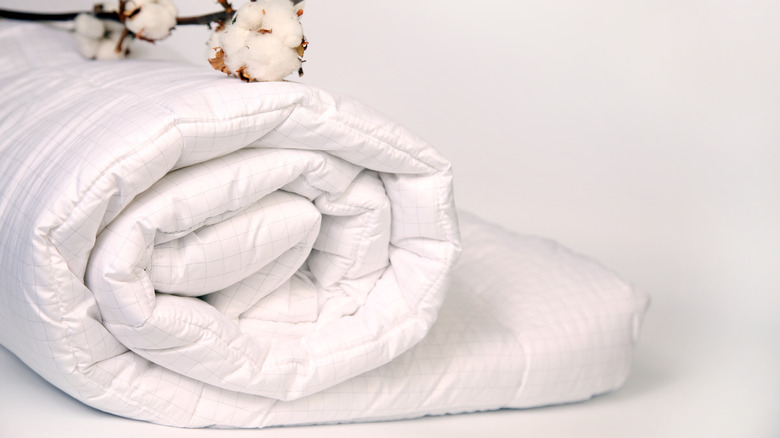Tips To Wash These 8 Items That Are Simply Too Big To Fit In Your Washer
Washing machines are the height of convenience, especially if you have messy pets or children. With the wealth of products and stain removers that can be paired with the washing machine, it almost feels like there's nothing it can't clean up; expensive dry-cleaning aside. For objects that are too big for the washer, however, there's a bit of a gray zone. Obviously, never washing big items isn't an option, but it may seem silly to take some things to get professionally cleaned.
While good old-fashioned soap and water can go a long way, they sometimes don't cut it. There are other things to consider, too. What temperature should the water be? What soap can be used? For things that you wish you could just chuck into the washer and be done with, there's usually a hand-washing solution. The best part is that you don't need to buy other appliances or fancy cleaners in order to take care of your things; for most cleaning techniques, you can use things you are likely to already have around the house.
Remember to always check your product's tags for care instructions and warnings, and wear protective clothing if you are sensitive to cleaning materials or if you are using hot water. Never expose your unprotected skin to harsh chemicals, and always wash your hands thoroughly after cleaning any item in your home. If you need to let something soak, never leave large basins of water unattended near small children or animals.
How to clean large rugs
For common foot traffic, regular vacuuming and the occasional bit of spot cleaning work just fine to keep your rugs looking clean. Before you get to cleaning, always check the tag on your rug for manufacturer instructions to be sure you're not about to ruin your rug in an attempt to restore it.
It's best to break rug cleaning down into a few steps; vacuum, scrub, dry, and brush. You'll want to use either a rug cleaner–not carpet cleaner, which may be too strong for a rug– or a mild dish soap mixed with cold water in a bucket. You can then take a bristle brush or sponge and start scrubbing. Don't sub your scrubbing tool out with something harsh; while steel wool works great on some dishes, for example, it would certainly tear your rug fibers up. When you're done, take the rug outside or hang it above the tub to spray it down.
You can use a garden hose, shower head, or if all else fails, a few buckets of clean water. If the run-off water comes out dirty after a few passes, you may want to re-scrub. If you have a wet vacuum, use it to remove the excess water; without that, you can try using a squeegee. Once it's been rinsed thoroughly, leave the rug hanging to drip dry. Then, lay it flat so that it doesn't completely dry in that hanging position. Once it's completely dry, vacuum or brush it out.
Wash large stuffed toys
Some smaller stuffed animals can go in the wash, but large stuffed toys may not even fit in the washing machine. If the stuffed animals belong to your children, they may be delighted to find that "teddy" is going to take a bath instead of getting chucked in the wash with their clothes. Any large basin will do, but you'll need to be sure that the detergent you use is neutral, such as those for wool or silk. Once the stuffed toy is in the basin, you can use a bucket full of detergent diluted heavily by warm, but not hot, water. Before you start, remove any accessories on the toy that are not sewn on.
For tougher stains, use a bit more detergent. Scrub in circles, either with a towel, soft bristle brush, or sponge. Be gentle so that you don't accidentally tear any stitching. Once you've given the toy a good scrub-down, use a towel damp with clean water to rinse the stuffed animal. You can towel-dry your toy and let it air dry. Using a hair dryer or leaving the toy out in the sun to dry can be a bit of a gamble; in the sun, you could unintentionally bleach the color of the stuffed animal, and if there are synthetic materials on the toy, you could potentially melt them with a hair dryer. Once the toy is dry, gently comb it out with a soft-bristle brush.
Clean your pregnancy pillows or body pillows the same way
Body pillows should be cleaned every three to six months, as they can build up allergens and microbes. To hand-wash a body or pregnancy pillow, remove the pillowcase first; that can be machine washed unless otherwise specified by the manufacturer. For a pregnancy pillow, be sure that the detergent you are using is safe for the owner, who may be sensitive to certain soaps and smells.
Next, fill a bathtub or other deep basin with a mixture of cold soapy water. Ideally, you should use a mild detergent as your soap, but a diluted regular detergent can also work. Mix the water until it has suds, then submerge the pillow. Once the pillow has soaked through, you can start to wash it; your hands should do just fine, but you can use a cloth or sponge on any lingering stains or spots. Massage the soap water through your pillow, then drain the tub and thoroughly rinse the pillow. Compress the pillow so that excess water is squeezed out, but don't be too harsh, as you can permanently misshape the pillow with excessive force. Finally, pat the pillow dry with a towel and set it out to air dry. You can leave the pillow out in the sun to both speed up the process and kill lingering bacteria and even mites. Make sure it is dry all the way through before putting the pillowcase back on.
Try washing your couch cushions for cleaner living
No matter how diligent you are in keeping your furniture pristine, it will eventually begin to look a bit crusty without a good washing every now and then. This especially goes for everyday-use items like your living room couch, and more specifically, its cushions. Almost all couch cushions will be too big to chuck into the washing machine, and not all cushions actually detach from the frame. You can go the extra mile with a couch cleaner or a steam cleaner, but otherwise, items you have at home will do. All you need to clean your couch cushions is white vinegar, dish soap, and baking soda.
Before attempting to clean your couch, check the manufacturer tags. "W" for water-based cleaning is your green light, but anything else and you may need to call in the pros. Once you're set, vacuum down the couch. If there are a lot of stubborn hairs, you'll want to use a lint cleaner as well. Then, using a mixture of vinegar, water, and mild dish soap, you can use a soaked rag to rub the stains out. Make sure to rinse with a water-only rag when you're finished. You may have to repeat this step a few times to completely get stains out. Without stains, you can just use a rag with a bit of soapy water to wipe down the entire cushion. Then, let it air dry.
Regularly clean your baby's crib mattress
Are there any mess-makers more notorious than babies? Some days, it may seem impossible to keep your little one clean for more than a few hours at a time, and all that gunk that gets on their onesie certainly transfers to their crib mattress. While you can most likely wash their bedding or swaddles in the washing machine, the mattress certainly can't go in.
As with most things, the first step will be to check the mattress tag for care instructions — most specifically if you can use hot or cold water. If possible, use hot or warm water. Next, you'll want to vacuum the mattress. You'll most likely use an attachment for this. Try to wipe down the vacuum attachment so that you are not unintentionally leaving germs and allergens all over the crib surface beforehand. Using water and either a mild detergent or dish soap, scrub the mattress thoroughly with a wet cloth. Wipe over it with a water-only cloth to remove any soap residue when you're finished. For stains, repeat the process a few times. You can then spray the mattress with a disinfecting spray to prevent mildew and other germs from taking hold in the wet mattress. Make sure the mattress is completely dry before putting bedding or your baby back on it. You can do this with dry towels and a healthy dose of sunlight.
Wash your pet beds for their health and yours
Outside pets track in countless allergens and debris to their pet beds, and indoor animals have plenty of hair and skin cells to shed as well. With that in mind, it's a good idea to regularly clean your pet's bed for their comfort and health as well as the health of those in your home. For a bed with a removable cover, you should vacuum or use a lint roller to remove the excess hair on the cover before throwing it in the wash. The bed, however, may be too big to go in the washer, or you may simply not wish to put it in the machine to avoid misshaping it.
For non-removable covers and the bed underneath removable covers, the process is the same. Vacuum and lint roll again to remove debris and hair. Fill a large container or tub with non-toxic detergent or mild dish soap, and, depending on the tag's instructions, hot, warm, or cool water. Let the bed soak for up to twenty minutes; if the water is overly dirty, you may wish to drain the basin and fill it with fresh soapy water before continuing. Scrub the bed with a cloth, soft bristle brush, or your hands; you can use a toothbrush to get in the corners. Scrubbing with baking soda can help lift odors and stains. Once you're done, rinse it thoroughly and leave it out to dry in the sun.
Clean heavy washable coats yourself
Depending on what kind of coat you have, instructions can vary greatly on how to clean your garment. Many heavy coats are dry-clean only, and even those that can be water-washed should be carefully assessed to ensure cleaning won't damage them. Down jackets and coats are fairly common; check the tags for cleaning instructions, but in general, there is a simple process to cleaning them.
To start, wipe down the coat's exterior. You can do this with a rag or soft bristle brush. It's best to fasten the coat completely, including the pockets, with zippers, snaps, and velcro. Set up a basin with enough space to completely submerge the jacket and fill it with cool water mixed with down-safe detergent. Completely soak the jacket and leave it submerged for an hour. Then, soak the jacket in clean, cold water to rinse the soap out; you'll want to rinse as many times as it takes for the water to come out completely suds-free. Squeeze out the excess water, but don't wring the coat! In some cases, you can use your dryer's low-heat seating to dry your jacket. Otherwise, pat it dry with towels and hang it up to dry. You will need to do this in a well-ventilated area, and you will have to return to fluff the jacket almost hourly to make sure the down does not clump. It will take roughly two days to dry completely.
Wash comforters that are too big and heavy for the machine
Maintaining your comforter or duvet can be done with spot-cleaning, but like all bedding, it should still be regularly washed. This can be difficult when many washers are too small for heavy items like a comforter, and some duvets–king or California king size–may be too large and heavy for any washing machine. The solution isn't to wash your sheets and ignore everything on top, as some people may believe. Even with sheets separating your body from your comforter, you still end up touching the comforter often, and your sweat and other contaminants are likely to make it through the sheets. This goes doubly for if you have recently been ill; clean your comforter as soon as you're well again to get rid of the lingering germs.
Cleaning comforters is easiest to do in the bathtub, which should be large enough to accommodate any comforter's large size. Fill the tub with warm water — not hot — and a mix of laundry detergent. Check the tags on your comforter to be sure your detergent is compatible. Submerge the comforter and let it sit for a while to loosen any dust or dirt in the fibers, then get to massaging and stirring to bust out anything that hasn't naturally seeped out. Drain the tub, rinse the blanket either with another bath or by using the shower head, squeeze out the water, and then hang the comforter to dry.
